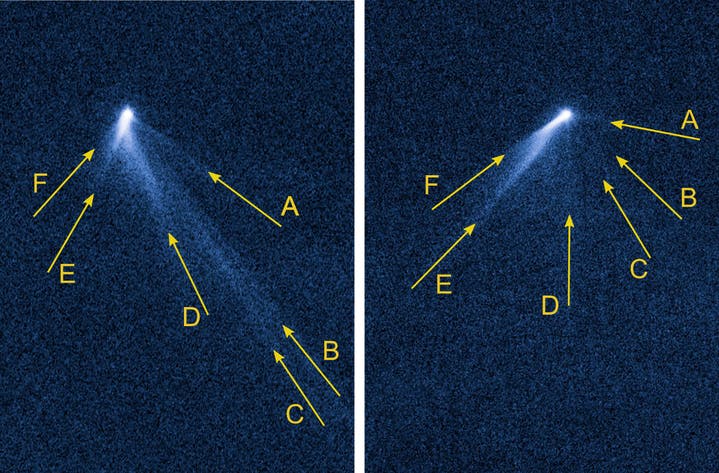This oddball cosmic body, called P/2013 P5, has puzzled astronomers for a while. By mass and orbit, it can only be classed as an asteroid, but the fact that it trails gas or dust would make it a comet. In fact, this weird rock has six tails, which would maybe make it a supercomet! Researchers at the Max Planck Institute for Solar System Research believe they have finally unraveled the mystery, though: P/2013 P5 is rotating so fast under the influence of solar pressure that it constantly loses material into space.
The old classification of asteroids and comets in our solar system goes something like this: asteroids are nothing but rocks whose structure and overall appearance hasn’t changed or morphed for billions of years, apart from the occasional impacts here and there; comets on the other hand are “gas and dust ejectors”, as material at its surface, liked iced water, becomes vaporized releasing dust and gas which forms the iconic trailing tail we all know.

Hubble space telescope images of the space body taken on 10 September (left) and 23 September 2013 (right). These show P/2013 P5 with six tails, which surround it like the spokes of a cartwheel. While most of the tails became less bright between the observations, tail F significantly increased in brightness. © NASA / HST
Over the years, however, scientists have discovered some cosmic bodies that don’t apparently fit any category. A comet in the asteroid belt? Or an asteroid which ejects gas and dust? This becomes even more confusing when you hear some scientists talk about active asteroids or main-belt comets. So, where does this weird P/2013 P5 fit in?
Photos taken this August by Hubble showed that the object had adorned itself with a tail. An impact with another smaller body could have penetrated deep through a maybe exposed a pocket of water to create the trail. But P/2013 P5 hasn’t one, but six tail. The chances of being hit six times is improbable. Also, since P/2013 P5 moves at the inner edge of the asteroid belt – i.e. very close to the Sun for an asteroid – it should no longer contain any ice at all, so Max Plank astronomers looked closer.
Driven by sunlight pressure, it was found that the object moves so fast that it loses mass. Since it hits the rugged surface at different angles, all in all it can produce a total angular momentum which accelerates its rotation more and more. At some stage, this will cause the centrifugal force at the equator to become stronger than the weak gravitational force of the body, which has a diameter of only 240 metres and is thus quite small; matter is therefore ejected from the surface. So, P/2013 P5 reputation is saved. It truly is an asteroid, though an oddball one.
To demonstrate these ideas, the Max Plank scientists ran a simulation and succeeded in reconstructing precisely these changes.
“Our computations and the actual observations are in very good agreement,” was the conclusion drawn by Jessica Agarwal, who carried out the computations. “It is particularly encouraging that we were able to achieve good reproduction of the temporal development between the two days of observation.”
The multi-talented asteroid was described in a paper published in the Astrophysical Journal Letters.









